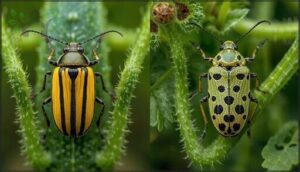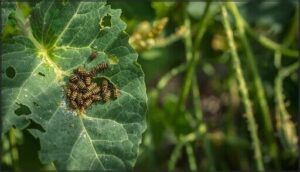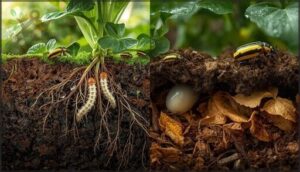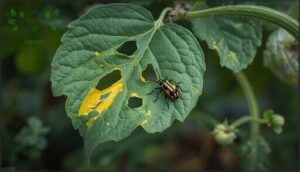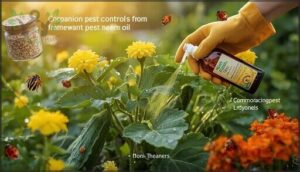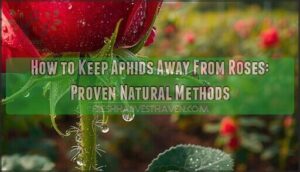This site is supported by our readers. We may earn a commission, at no cost to you, if you purchase through links.
Last summer, a gardener I know lost half her cucumber crop in under two weeks. The culprit wasn’t drought or disease—it was an army of tiny beetles no bigger than a grain of rice.
Dealing with cucumber beetle damage starts the moment you spot those telltale yellow-and-black insects on your leaves, because once they settle in, the destruction accelerates fast. These pests don’t just chew holes in foliage; they spread bacterial wilt, scar developing fruit, and lay eggs that hatch into root-munching larvae.
The good news? You can stop them before they devastate your harvest, whether you prefer organic methods or a full integrated approach.
Table Of Contents
Key Takeaways
- You can cut cucumber beetle damage by combining early detection (scouting every 2-3 days during the seedling stage), physical barriers like row covers until flowering, and strategic crop rotation at least half a mile from last year’s planting site to reduce populations by up to 50%.
- These pests don’t just chew leaves—they’re vectors for bacterial wilt that kills cucumbers within 7-14 days of symptom onset, and even a single beetle per seedling during the cotyledon to three-leaf stage causes economic losses worth replanting.
- Organic controls like yellow sticky traps, diatomaceous earth reapplied after rain, and neem oil (which cuts infestations 46-53%) work best when layered together rather than used alone, with trap crops like Blue Hubbard squash boosting marketable yields by 33%.
- Your garden’s natural allies—beneficial nematodes, lady beetles, and tachinid flies attracted by floral resource strips—can reduce beetle populations by 35% when you maintain organic mulch and keep soil temperatures between 59-69°F for maximum predator activity.
Identifying Cucumber Beetle Infestations
Before you can tackle cucumber beetle problems, it’s important to know exactly what you’re up against. Spotting their telltale signs early can make all the difference for your plants.
Here’s what to look for as you inspect your garden.
Physical Characteristics and Markings
Cucumber beetle identification starts with a keen eye for physical characteristics of beetles: think yellow to greenish elytra patterns, black head coloration, and prominent antennae features. Adults, roughly 1/4 inch long, show clear size comparison to lookalikes. Larval morphology reveals creamy white, worm-like bodies with dark heads.
Such details are touchstones in understanding cucumber beetle biology. Understanding cucumber beetle is important for effective management.
Differentiating Striped and Spotted Cucumber Beetles
Sharp eyes make cucumber beetle identification easier—striped cucumber beetles flash three black stripes over yellow wing covers, while spotted cucumber beetles show twelve black dots on greenish-yellow backs.
For marking distinctions, striped beetles favor cucurbit hosts and deliver root damage, unlike spotteds, which feed mainly on leaves. GardenTech recommends using Sevin Insect Killer to control these pests.
Behavior patterns, larval differences, and geographic ranges further separate these persistent cucumber beetle damage agents.
Recognizing Signs of Beetle Activity
If you’re seeing chewed leaves, holes, or dimples on cucurbits, you’re likely spotting early signs of cucumber beetle activity. Watch for frass—a telltale clue—and clusters of beetles gathering on your plants.
Don’t ignore wilt symptoms either. Early detection, especially of feeding patterns and aggregation behavior, is your best bet at stopping cucumber beetle damage before it spreads.
Understanding The Life Cycle and Overwintering Habits
Once you’ve spotted the damage, understanding when and how these beetles operate gives you the upper hand. Cucumber beetles complete their life cycle in 30 to 60 days, with egg hatch rates hitting 75–85%.
Larvae develop underground for 2 to 6 weeks, while pupal survival depends on undisturbed soil.
Adults emerge when temperatures exceed 55°F, with spotted beetles migrating up to 500 miles during warm periods.
Assessing Cucumber Beetle Damage
Once you spot cucumber beetles, you need to understand what they’re actually doing to your plants.
The damage goes beyond cosmetic—it affects plant health, yield, and long-term garden success. Here’s what to look for and why it matters.
Chewed Leaves, Vines, and Fruit Scarring
When beetles attack, you’ll notice the damage fast—both to plant tissue and your harvest’s bottom line. These pests don’t discriminate, targeting:
- Foliage – Leaf area loss can reach 25% on seedlings, reducing photosynthesis and vigor by up to 20%.
- Stems – Vine girdling threatens 30–40% of affected plants with mortality.
- Fruit – Scarring damages fruit marketability, affecting 12–40% of harvested produce.
- Economics – Damage clustering and economic thresholds demand vigilant pest control.
Seedling Vulnerability and Stunted Growth
Young plants are particularly vulnerable to cucumber beetles, which can cause significant damage during the cotyledon to three-leaf stage. At this stage, seedlings struggle to recover from feeding damage, and even one beetle per plant can lead to economic losses. Larval root damage disrupts water uptake, while adult beetles scar stems and increase disease susceptibility. Without preventative measures like row covers, growers often face replanting costs and long-term yield reductions. Growth metrics clearly illustrate the impact: stunted plants result in smaller harvests.
| Growth Stage | Beetle Threshold | Primary Risk |
|---|---|---|
| Cotyledon–3 leaf | 0.5–1 per seedling | Mortality, stunting |
| Root zone | Larval feeding | Nutrient disruption |
| Early establishment | >1 beetle average | Stand reduction |
Disease Transmission: Bacterial Wilt and Mosaic Virus
Beyond chewing leaves, cucumber beetles act as vectors for devastating plant diseases. Striped beetles spread bacterial wilt disease by depositing infected frass into feeding wounds, with plants dying within 7–14 days of symptom development. They also carry cucumber mosaic virus, though aphids remain primary transmitters.
Bacterial wilt generally causes 10–20% losses, but severe epidemics result in total crop failure, creating massive economic impact across cucurbit operations.
Long-term Impacts on Cucurbit Crops
Chronic insect infestation doesn’t just hurt this season—it compounds over time. Fields with continuous cucurbit crops see beetle pressure rise 12–18% annually, while yield reduction reaches 54% at high densities.
Marketability losses exceed 30% in commercial operations due to fruit scarring. Without crop rotation and proactive pest management, you’re setting up a cycle where population trends worsen and ecological effects ripple through pollinator networks and plant diseases intensify.
Organic and Non-Toxic Control Methods
Once you’ve spotted cucumber beetles and assessed the damage, it’s time to take action without reaching for harsh chemicals.
You have several effective organic options that target these pests while keeping your garden safe for beneficial insects and pollinators.
Let’s look at the most reliable methods you can start using right away.
Hand-picking and Physical Removal
Sometimes the simplest approach wins. Hand-picking adult beetles directly off your plants can reduce populations by up to 50% when done consistently.
Here’s how to improve handpicking effectiveness:
- Inspect every 2–3 days during peak activity, targeting dawn or dusk when beetles move slowly
- Drop collected beetles into soapy water for quick disposal
- Focus on seedlings first—you’ll prevent up to 80% of early damage and disrupt reproduction cycles before larvae establish
Pair physical removal with row covers or trap crops for integrated strategies that cut beetle density by 40–60%.
Using Yellow Sticky Traps
Yellow sticky traps serve as your early warning system and capture tool rolled into one. Position traps just above the crop canopy near garden entrances to intercept flying cucumber beetles before they settle.
Check every 7–10 days—when you count 20 beetles per trap over 48 hours, it’s time for treatment. DIY versions using yellow cups with Tangle-Trap work as well as commercial options.
Applying Diatomaceous Earth and Kaolin Clay
When beetles breach your sticky trap perimeter, two organic pest control powders offer nontoxic pest control methods worth deploying. Applying diatomaceous earth around plant bases creates a sharp mineral barrier that punctures beetle exoskeletons, while kaolin clay coats foliage to confuse and deter feeding.
Application frequency matters:
- Reapply every 7–10 days
- Refresh immediately after rain—weather impact strips effectiveness
- Maintain thin, even layer thickness for plant coverage
Combining methods amplifies control.
Neem Oil and Pyrethrin-based Sprays
Beyond powders, liquid organic pest control options target cucumber beetles more directly. Neem oil functions as an antifeedant, reducing feeding damage by disrupting beetle hormones—field trials show 46–53% infestation reductions with repeated use. Pyrethrins deliver contact paralysis but require evening application timing to protect pollinators. Neither eliminates beetles alone; integrated use with physical barriers and crop rotation achieves sustainable resistance management against persistent populations.
| Product | Primary Action | Spray Effectiveness |
|---|---|---|
| Neem Oil | Antifeedant, hormone disruption | 46–53% reduction |
| Pyrethrins | Contact paralysis | 20–49% reduction |
| Combined (Azera) | Dual mechanism | Up to 62% reduction |
Preventing Future Cucumber Beetle Problems
Once you’ve dealt with an active infestation, your next move is making sure cucumber beetles don’t come back next season. Prevention isn’t complicated, but it does require some planning and a few strategic changes to how you manage your garden.
The following approaches will help you break the beetle’s life cycle and protect your cucurbit crops year after year.
Crop Rotation and Soil Management
When you rotate cucurbits at least half a mile away from last year’s field, you can slash early beetle numbers by half. Crop rotation techniques work best with two-year gaps and non-host cover crops in between.
Tillage after harvest, vermicompost additions, and roller-crimped mulches all boost soil health while supporting beneficial nematodes and beetles that prey on cucumber pests naturally.
Removing Garden Debris and Overwintering Sites
Tilling in autumn works like an eviction notice for overwintering beetles. Deep tillage—at least 6 inches—buries crop residue that shelters adults through winter.
You’ll want to remove or shred debris right after harvest, denying beetles the protected sites they prefer in hedgerows and field margins. Adding winter cover crops accelerates decomposition and closes those hiding spots before temperatures drop below 55°F.
Utilizing Row Covers and Reflective Mulch
When you install row covers at transplanting, you’ll achieve nearly complete cucumber beetle exclusion until flowering—but remember row cover timing matters since you’ll need to remove them for pollinator access.
Reflective mulch provides ongoing deterrence, cutting beetle counts by up to 5.5 times compared to black plastic.
Combined strategies deliver the strongest protection for cucurbit crops, though cost considerations and pollinator exclusion require planning ahead.
Choosing Resistant Cucurbit Varieties
If you want a long-term edge over cucumber beetles, selecting resistant cucurbit varieties cuts both beetle feeding and disease transmission.
Cucumbers like County Fair and Arkansas Little Leaf resist bacterial wilt, while Success PM straightneck squash deters striped beetles considerably better than zucchini types.
Resistant varieties reduce beetle counts from over 16 per plant to just three, slashing yield loss by 45% without extra sprays.
Integrated Pest Management Strategies
You don’t have to fight cucumber beetles alone—building a complete management system means tapping into nature’s own defenses while keeping a few strategic tools in your back pocket.
The best approach combines multiple tactics that work together, from recruiting helpful insects to knowing when a targeted spray makes sense.
Here’s how to create a balanced plan that keeps beetle populations under control without turning your garden into a chemical battleground.
Companion Planting and Trap Crops
You can turn your garden into a beetle-blocking fortress with the right plant selection and spatial arrangement. Companion planting vegetables like radish and buckwheat cuts cucumber beetle populations by half, while trap cropping with Blue Hubbard squash lures pests away from your harvest.
Consider these proven strategies:
- Plant marigolds and nasturtium around cucurbits to repel beetles naturally
- Deploy perimeter trap crops at least 9 feet wide for maximum protection
- Combine companion plants with reflective mulch for additive yield improvement
Field trials show trap cropping boosts marketable yields by 33%, delivering real economic benefits—that’s an extra $1,480 per acre while protecting your cucumbers from bacterial wilt and feeding damage.
Trap cropping increases marketable yields by 33% and adds $1,480 per acre while shielding cucumbers from bacterial wilt and beetle damage
Attracting Beneficial Insects and Nematodes
Your garden ecosystem can do the heavy lifting when you invite the right allies. Lady beetles, green lacewings, and tachinid flies target beetle eggs and larvae, while beneficial nematodes attack underground. Floral resource strips can double parasitic fly presence and boost parasitism rates by 22%. Application timing matters—nematodes work best in 59–69°F soil, losing over 50% efficacy when conditions turn dry or excessively hot.
Organic matter benefits extend beyond fertility—mulched soils yield 32% fewer beetles and foster biological control organisms that persist throughout the season.
| Control Method | Key Benefits | Critical Success Factors |
|---|---|---|
| Beneficial insects (lady beetles, lacewings) | Prey on eggs and larvae; natural predators reduce populations by 35% | Floral resource strips; organic matter benefits soil health |
| Tachinid flies | Parasitize adult beetles; increase control up to 22% | Nectar plants nearby; early-season introduction |
| Beneficial nematodes | Attack pupae; reduce emergence 28–40% | Nematode soil viability 59–69°F; moist conditions; reapply as needed |
| Reflective mulch impact | Moderate microclimate; boost predatory arthropod activity | Combined with organic mulching; attracts predatory insects |
Targeted Use of Chemical Controls
Looking to stay ahead of beetle outbreaks? Chemical controls for cucumber beetles work best when every move counts—think chess, not checkers. Keep your strategy tight:
- Apply pesticides right before sunrise or after sunset for pollinator safety.
- Rotate insecticide classes to slow insecticide resistance.
- Respect dosage efficacy and heed regulatory compliance, especially for pyrethrin-based insecticides and neonicotinoids.
Monitoring and Ongoing Population Management
How do you stay on top of cucumber beetle populations without wasting time or money? Start scouting two to three times weekly when seedlings emerge, focusing on crop borders where beetles first cluster.
Economic thresholds guide action: one beetle per cucumber plant signals intervention, while squash tolerates five.
Mass-trapping and data-driven IPM improve your monitoring, balancing preventive measures and cultural controls for sustainable, season-long management.
Frequently Asked Questions (FAQs)
Can cucumber beetles infest indoor greenhouse cucurbits?
An ounce of prevention is worth a pound of cure. Cucumber beetles readily invade greenhouse cucurbits through cracks and openings.
Installing insect screens with 8 x 0 mm mesh effectively blocks their entry while permitting proper airflow.
What temperature kills overwintering cucumber beetle adults?
Overwintering cucumber beetle adults succumb to lethal cold exposure when temperatures drop below −5°C (3°F). Extended periods at this threshold disrupt their supercooling points, causing fatal cellular damage and sharply reducing winter survival rates.
Do cucumber beetles attack ornamental gourds too?
Your prized decorative gourd display can turn spotty overnight—cucumber beetles don’t discriminate. These pests attack ornamental gourds just as aggressively as edible cucurbits, feeding on flowers, foliage, and young fruits throughout the season.
How quickly does bacterial wilt kill plants?
Wilting symptom onset happens between 4 and 21 days after infection, depending on the crop. Cucumbers and melons die within days, while pumpkins take up to two weeks.
Mortality rates are generally fatal once symptoms appear.
Are there natural cucumber beetle repellent sprays?
Yes, several natural remedies work well. Neem oil spray disrupts beetle feeding and reproduction. Kaolin clay creates a protective barrier. Garlic and hot pepper sprays mask plant scents. Essential oils like peppermint deter beetles effectively.
Conclusion
Think of your garden as a fortress: the beetles are already at the gate, but you hold the keys to every defense. Dealing with cucumber beetle damage isn’t about winning one battle—it’s about building a system where pests lose before they start.
Rotate crops, monitor daily, deploy barriers early, and don’t hesitate to intervene. Your cucurbits will reward vigilance with healthy vines and abundant harvests all season long.



